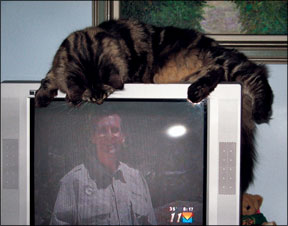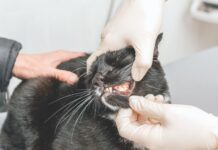I have two cats, both five years old. Both eat dry and canned food and live exclusively indoors. My male cat has cervical line lesions of his teeth. Hes had two teeth removed already, and my veterinarian told me his problem could get worse. Can you tell me about this condition and what I can do to slow it down? My veterinarian said my cat should be examined every six months, but what else can I do for him?
Cervical line lesions ultimately affect about one third of cats, with the likelihood of disease increasing with age. For reasons that escape me, this condition goes by lots of different names: feline dental resorption, feline oral resorptive lesions, feline odontoclastic resorptive lesions, neck lesions, resorptive lesions, and the aforementioned cervical line lesions. Ill use the abbreviation FORL, which stands for feline odontoclastic resorptive lesion, for our discussion.
FORLs are cavitylike pits that form most often near the gumline, although they can appear anywhere on the crown or root surface of a tooth. Research has thus far failed to illuminate a cause, although many theories have been proposed and discounted. Depending on how far theyve progressed, FORLs can be very, very painful. Tooth grinding is a way that many cats show their discomfort; other cats choose to chew only on one side of their mouths. Still others may suddenly open their mouths or “chatter” their teeth while chewing. Some may have bad breath, paw at their faces, drool excessively, have a reduced appetite or lose weight, or they may show no signs of disease whatsoever, suffering in silence.
Evidence of FORLs can usually be found during careful oral examination, which sometimes must be done while the cat is sedated or anesthetized. Lesions are often found concealed beneath reddened, gumlike tissue that appears to be growing over the tooth, but sometimes high-quality dental X-rays are necessary to disclose their presence, especially when theyre hidden in the root area of the tooth. A variety of sophisticated dental treatments have been used, but none halts progression of the disease. Extraction of the affected tooth is the current treatment of choice, and it is highly successful in relieving the severe pain the disease causes. I suggest you heed your veterinarians counsel and have your cat examined every six months. The examinations wont prevent the disease, of course, but they can aid early diagnosis and treatment and spare your cat considerable discomfort.
I have one fourteen-year-old Siamese cat and two kittens, one just over a year and the other 11 months old. Probably my cats are not special in that they love things that radiate heat. The winter months will find them snuggled up next to

288
radiators, and even on top of them, all stretched out and content. They are also fond of sunny spots on windowsills and the top of the dishwasher; all of this I find quite endearing and harmless. But last year I lost two cats to cancer – one at 16 years of age, the other at 13. I had always been concerned about their habit of settling atop the television, computer, cable box or other electronic components. The kittens have taken up these same habits. I wonder if those units emit anything that could be harmful to the cats that rest on them for hours each day. What can you tell me? Should I be concerned?
Ah, cats and sunshine. No one really knows why cats seek islands of sunshine to slumber upon, but clearly they enjoy the experience. I admit that I receive vicarious pleasure from watching my at-home kitty, Schmutz, snoozing contentedly in the rays. His behavior is probably motivated by a desire to bask in warm places, which your cats love of other toasty spots seems to affirm.
I have seen no studies suggesting that close exposure to household electronic components is harmful in any way to cats, even if theyre exposed over long periods of time. Im unaware of compelling evidence suggesting harm to other species, either, including humans. But to know for sure, extensive (and expensive) epidemiological studies contrasting the health of exposed cats to those with no exposure would be necessary and, to date, none has been performed.
Bottom line: You neednt worry about your cats health, but you can eliminate ANY possibility of risk by simply hitting the “off” switch when youre not using the electronic components. Even electronic equipment that remains in a “standby mode” when switched off generates less cat-attracting heat when you flick the switch. Plus, therell be less cat hair and dander settling into sensitive equipment and plugging up the cooling systems (perhaps shortening the life of the component, even if not the cats), and you could save a fair amount of electricity in the bargain. The rule in my house is to turn it off if its not being used.
v


